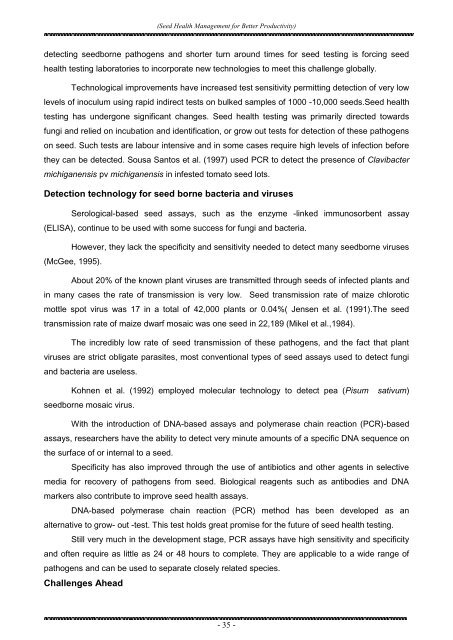Seed Health Management for Better Productivity - Govind Ballabh ...
Seed Health Management for Better Productivity - Govind Ballabh ...
Seed Health Management for Better Productivity - Govind Ballabh ...
You also want an ePaper? Increase the reach of your titles
YUMPU automatically turns print PDFs into web optimized ePapers that Google loves.
(<strong>Seed</strong> <strong>Health</strong> <strong>Management</strong> <strong>for</strong> <strong>Better</strong> <strong>Productivity</strong>)detecting seedborne pathogens and shorter turn around times <strong>for</strong> seed testing is <strong>for</strong>cing seedhealth testing laboratories to incorporate new technologies to meet this challenge globally.Technological improvements have increased test sensitivity permitting detection of very lowlevels of inoculum using rapid indirect tests on bulked samples of 1000 -10,000 seeds.<strong>Seed</strong> healthtesting has undergone significant changes. <strong>Seed</strong> health testing was primarily directed towardsfungi and relied on incubation and identification, or grow out tests <strong>for</strong> detection of these pathogenson seed. Such tests are labour intensive and in some cases require high levels of infection be<strong>for</strong>ethey can be detected. Sousa Santos et al. (1997) used PCR to detect the presence of Clavibactermichiganensis pv michiganensis in infested tomato seed lots.Detection technology <strong>for</strong> seed borne bacteria and virusesSerological-based seed assays, such as the enzyme -linked immunosorbent assay(ELISA), continue to be used with some success <strong>for</strong> fungi and bacteria.However, they lack the specificity and sensitivity needed to detect many seedborne viruses(McGee, 1995).About 20% of the known plant viruses are transmitted through seeds of infected plants andin many cases the rate of transmission is very low. <strong>Seed</strong> transmission rate of maize chloroticmottle spot virus was 17 in a total of 42,000 plants or 0.04%( Jensen et al. (1991).The seedtransmission rate of maize dwarf mosaic was one seed in 22,189 (Mikel et al.,1984).The incredibly low rate of seed transmission of these pathogens, and the fact that plantviruses are strict obligate parasites, most conventional types of seed assays used to detect fungiand bacteria are useless.Kohnen et al. (1992) employed molecular technology to detect pea (Pisumseedborne mosaic virus.sativum)With the introduction of DNA-based assays and polymerase chain reaction (PCR)-basedassays, researchers have the ability to detect very minute amounts of a specific DNA sequence onthe surface of or internal to a seed.Specificity has also improved through the use of antibiotics and other agents in selectivemedia <strong>for</strong> recovery of pathogens from seed. Biological reagents such as antibodies and DNAmarkers also contribute to improve seed health assays.DNA-based polymerase chain reaction (PCR) method has been developed as analternative to grow- out -test. This test holds great promise <strong>for</strong> the future of seed health testing.Still very much in the development stage, PCR assays have high sensitivity and specificityand often require as little as 24 or 48 hours to complete. They are applicable to a wide range ofpathogens and can be used to separate closely related species.Challenges Ahead- 35 -
















